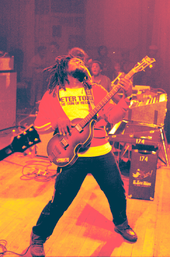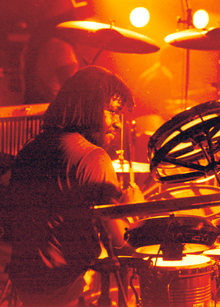
Robbie Shakespeare
Reggae drumbeats fall into three main categories: One drop, Rockers, and Steppers. With the One drop, the emphasis is entirely on the backbeat (usually on the snare, or as a rim shot combined with bass drum). Beat one is empty except for a closed high hat commonly used, which is unusual in popular music. There is some controversy about whether reggae should be counted so that this beat falls on two and four, or whether it should be counted twice as fast, so it falls on three. An example played by Barrett can be heard in the Bob Marley and the Wailers song "One Drop". Barrett often used an unusual triplet cross-rhythm on the hi-hat, which can be heard on many recordings by Bob Marley and the Wailers, such as "Running Away" on the Kaya album.

Sly Dunbar
An emphasis on the backbeat is found in all reggae drumbeats, but with the Rockers beat, the emphasis is on all four beats of the bar (usually on bass drum). This beat was pioneered by Sly and Robbie, who later helped create the "Rub-a-Dub" sound that greatly influenced dancehall. Sly has stated he was influenced to create this style by listening to American drummer Earl Young as well as other disco and R&B drummers in the early to mid-1970s, as stated in the book "Wailing Blues". The prototypical example of the style is found in Sly Dunbar's drumming on "Right Time" by the Mighty Diamonds. The Rockers beat is not always straightforward, and various syncopations are often included. An example of this is the Black Uhurusong "Sponji Reggae".
In Steppers, the bass drum plays every quarter beat of the bar, giving the beat an insistent drive. An example is "Exodus" by Bob Marley and the Wailers. Another common name for the Steppers beat is the "four on the floor". Burning Spear's 1975 song "Red, Gold, and Green" (with Leroy Wallace on drums) is one of the earliest examples. The Steppers beat was adopted (at a much higher tempo) by some 2 Tone ska revival bands of the late 1970s and early 1980s.
An unusual characteristic of reggae drumming is that the drum fills often do not end with a climactic cymbal. A wide range of other percussion instrumentation are used in reggae.Bongos are often used to play free, improvised patterns, with heavy use of African-style cross-rhythms. Cowbells, claves and shakers tend to have more defined roles and a set pattern.
Bass

Aston Barret
The bass guitar often plays the dominant role in reggae, and the drum and bass is often the most important part of what is called, in Jamaican music, a riddim (rhythm), a (usually simple) piece of music that's used repeatedly by different artists to write and record songs with. Literally hundreds of reggae singers have released different songs recorded over the same rhythm. The central role of the bass can be particularly heard in dub music — which gives an even bigger role to the drum and bass line, reducing the vocals and other instruments to peripheral roles.
The bass sound in reggae is thick and heavy, and equalized so the upper frequencies are removed and the lower frequencies emphasized. The bass line is often a repeated two or four bar riff when simple chord progressions are used. The simplest example of this might be Robbie Shakespeare's bass line for the Black Uhuru hit "Shine Eye Gal". In the case of more complex harmonic structures, such as John Holt's version of "Stranger In Love", these simpler patterns are altered to follow the chord progression either by directly moving the pattern around or by changing some of the interior notes in the phrase to better support the chords.
Guitars

Al Anderson
The guitar in reggae usually plays on the off beat of the rhythm. So if one is counting in 4/4 time and counting 1 + 2 + 3 + 4 +, one would play a downstroke on the "and" part of the beat. A musical figure known as skank or the 'bang" has a very dampened, short and scratchy chop sound, almost like a percussion instrument. Sometimes a double chop is used when the guitar still plays the off beats, but also plays the following 8th beats on the up-stroke. An example is the intro to "Stir It Up" by The Wailers. Artist and producer Derrick Harriott says, “What happened was the musical thing was real widespread, but only among a certain sort of people. It was always a down-town thing, but more than just hearing the music. The equipment was so powerful and the vibe so strong that we feel it.”
Keyboards
From the late 1960s through to the early 1980s, a piano was often used in reggae to double the rhythm guitar's skank, playing the chords in astaccato style to add body, and playing occasional extra beats, runs and riffs. The piano part was widely taken over by synthesizers during the 1980s, although synthesizers have been used in a peripheral role since the 1970s to play incidental melodies and countermelodies. Larger bands may include either an additional keyboardist, to cover or replace horn and melody lines, or the main keyboardist filling these roles on two or more keyboards.
The reggae organ-shuffle is unique to reggae. Typically, a Hammond organ-style sound is used to play chords with a choppy feel. This is known as the bubble. This may be the most difficult reggae keyboard rhythm. The organ bubble can be broken down into 2 basic patterns. In the first, the 8th beats are played with a space-left-right-left-space-left-right-left pattern, where the spaces represent downbeats not played—that and the left-right-left falls on the ee-and-a, or and-2-and if counted at double time. In the second basic pattern, the left hand plays a double chop as described in the guitar section while the right hand plays longer notes on beat 2 (or beat 3 if counted at double time) or a syncopated pattern between the double chops. Both these patterns can be expanded on and improvised embellishments are sometimes used.
Horns
Horn sections are frequently used in reggae, often playing introductions and counter-melodies. Instruments included in a typical reggae horn section include saxophone, trumpet or trombone. In more recent times, real horns are sometimes replaced in reggae by synthesizers or recorded samples. The horn section is often arranged around the first horn, playing a simple melody or counter melody. The first horn is usually accompanied by the second horn playing the same melodic phrase in unison, one octave higher. The third horn usually plays the melody an octave and a fifth higher than the first horn. The horns are generally played fairly softly, usually resulting in a soothing sound. However, sometimes punchier, louder phrases are played for a more up-tempo and aggressive sound.
Vocals

UB40's former frontman Ali Campbell performing in 2009.
The vocals in reggae are less of a defining characteristic of the genre than the instrumentation and rhythm, as almost any song can be performed in a reggae style. However, it is very common for reggae to be sung in Jamaican Patois, Jamaican English, and Iyaric dialects. Vocal harmony parts are often used, either throughout the melody (as with vocal groups such as the Mighty Diamonds), or as a counterpoint to the main vocal line (as with the backing vocalists, the I-Threes). More complex vocal arrangements can be found in the works of groups like The Abyssinians andBritish reggae band Steel Pulse.
An unusual aspect of reggae singing is that many singers use tremolo (volume oscillation) rather than vibrato (pitch oscillation). Notable exponents of this technique include Horace Andy and vocal group Israel Vibration. The toasting vocal style is unique to reggae, originating whenDJs improvised spoken introductions to songs (or "toasts") to the point where it became a distinct rhythmic vocal style, and is generally considered to be a precursor to rap. It differs from rap mainly in that it is generally melodic, while rap is generally more a spoken form without melodic content.
Lyrical themes
Reggae is noted for its tradition of social criticism in its lyrics, although many reggae songs discuss lighter, more personal subjects, such as love and socializing. Many early reggae bands covered Motown or Atlantic soul and funk songs. Some reggae lyrics attempt to raise the political consciousness of the audience, such as by criticizing materialism, or by informing the listener about controversial subjects such as Apartheid. Many reggae songs promote the use of cannabis (also known as herb, ganja, or sinsemilla), considered a sacrament in the Rastafari movement. There are many artists who utilize religious themes in their music — whether it be discussing a specific religious topic, or simply giving praise to God (Jah). Other common socio-political topics in reggae songs include black nationalism, anti-racism, anti-colonialism, anti-capitalism and criticism of political systems and "Babylon". .
Criticism of dancehall and ragga lyrics
Some dancehall and ragga artists have been criticised for homophobia, including threats of violence. Buju Banton's song "Boom Bye-Bye" states that gays "haffi dead". Other notable dancehall artists who have been accused of homophobia include Elephant Man, Bounty Killer and Beenie Man. The controversy surrounding anti-gay lyrics has led to the cancellation of UK tours by Beenie Man and Sizzla. Toronto, Canada has also seen the cancellation of concerts due to artists such as Elephant Man and Sizzla refusing to conform to similar censorship pressures.
After lobbying from the Stop Murder Music coalition, the dancehall music industry agreed in 2005 to stop releasing songs that promote hatred and violence against gay people. In June 2007, Beenie Man, Sizzla and Capleton signed up to the Reggae Compassionate Act, in a deal brokered with top dancehall promoters and Stop Murder Music activists. They renounced homophobia and agreed to "not make statements or perform songs that incite hatred or violence against anyone from any community". Five artists targeted by the anti-homophobia campaign did not sign up to the act, including Elephant Man, TOK, Bounty Killa and Vybz Kartel. Buju Banton and Beenie Man both gained positive press coverage around the world for publicly renouncing homophobia by signing the Reggae Compassion Act. However, both of these artists have since denied any involvement in anti-homophobia work and both deny having signed any such act.

No comments:
Post a Comment